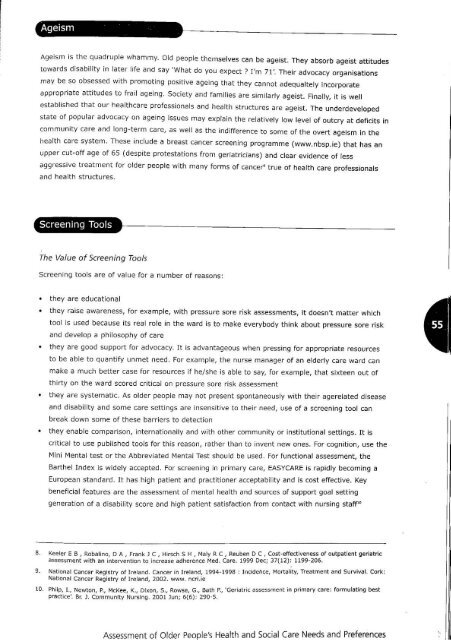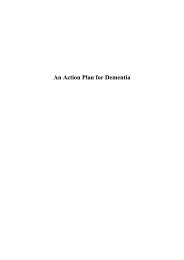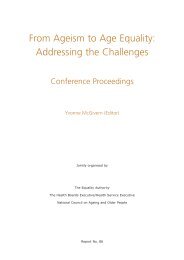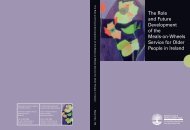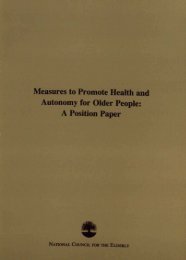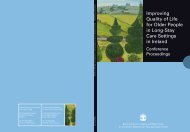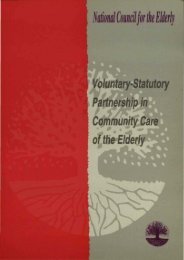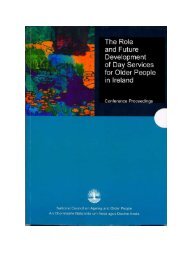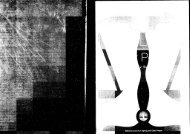Assessment of Older People's Health and Social Care Needs and ...
Assessment of Older People's Health and Social Care Needs and ...
Assessment of Older People's Health and Social Care Needs and ...
- No tags were found...
You also want an ePaper? Increase the reach of your titles
YUMPU automatically turns print PDFs into web optimized ePapers that Google loves.
<strong>Assessment</strong> <strong>of</strong> <strong>Older</strong> <strong>People's</strong> <strong>Health</strong> <strong>and</strong> <strong>Social</strong> <strong>Care</strong> <strong>Needs</strong> <strong>and</strong> PreferencesAgeismAgeism is the quadruple whammy. Old people themselves can be ageist. They absorb ageist attitudestowards disability in later life <strong>and</strong> say 'What do you expect? I'm 71'. Their advocacy organisationsmay be so obsessed with promoting positive ageing that they cannot adequaltely incorporateappropriate attitudes to frail ageing. Society <strong>and</strong> families are similarly ageist. Finally, it is wellestablished that our healthcare pr<strong>of</strong>essionals <strong>and</strong> health structures are ageist. The underdevelopedstate <strong>of</strong> popular advocacy on ageing issues may explain the relatively low level <strong>of</strong> outcry at deficits incommunity care <strong>and</strong> long-term care, as well as the indifference to some <strong>of</strong> the overt ageism in thehealth care system. These include a breast cancer screening programme (www.nbsp.ie) that has anupper cut-<strong>of</strong>f age <strong>of</strong> 65 (despite protestations from geriatricians) <strong>and</strong> clear evidence <strong>of</strong> lessaggressive treatment for older people with many forms <strong>of</strong> cancer' true <strong>of</strong> health care pr<strong>of</strong>essionals<strong>and</strong> health structures._r----------------------------------The Value <strong>of</strong> Screening ToolsScreening tools are <strong>of</strong> value for a number <strong>of</strong> reasons:they are educational• they raise awareness, for example, with pressure sore risk assessments, it doesn't matter whichtool is used because its real role in the ward is to make everybody think about pressure sore risk<strong>and</strong> develop a philosophy <strong>of</strong> care• they are good support for advocacy. It is advantageous when pressing for appropriate resourcesto be able to quantify unmet need. For example, the nurse manager <strong>of</strong> an elderly care ward canmake a much better case for resources if he/she is able to say, for example, that sixteen out <strong>of</strong>thirty on the ward scored critical on pressure sore risk assessmentthey are systematic. As older people may not present spontaneously with their agerelated disease<strong>and</strong> disability <strong>and</strong> some care settings are insensitive to their need, use <strong>of</strong> a screening tool canbreak down some <strong>of</strong> these barriers to detection• they enable comparison, internationally <strong>and</strong> with other community or institutional settings. It iscritical to use published tools for this reason, rather than to invent new ones. For cognition, use theMini Mental test or the Abbreviated Mental Test should be used. For functional assessment, theBarthel Index is widely accepted. For screening in primary care, EASYCARE is rapidly becoming aEuropean st<strong>and</strong>ard. It has high patient <strong>and</strong> practitioner acceptability <strong>and</strong> is cost effective. Keybeneficial features are the assessment <strong>of</strong> mental health <strong>and</strong> sources <strong>of</strong> support goal settinggeneration <strong>of</strong> a disability score <strong>and</strong> high patient satisfaction from contact with nursing staff'·8. Keeler E B , Robalino, D A , Frank J C , Hirsch S H , Maly RC, Reuben DC, Cost-effectiveness <strong>of</strong> outpatient geriatricassessment with an intervention to increase adherence Med. <strong>Care</strong>. 1999 Dec; 37(12): 1199-206.9. National Cancer Registry <strong>of</strong> Irel<strong>and</strong>. Cancer in Irel<strong>and</strong>, 1994-1998 : Incidehce, Mortality, Treatment <strong>and</strong> Survival. Cork:National Cancer Registry <strong>of</strong> Irel<strong>and</strong>, 2002. www.ncri.ie10. Philp, I., Newton, P., McKee, K., Dixon, S./ Rowse, G., Bath P" 'Geriatric assessment in primary care: formulating bestpractice'. Br. J. Community Nursing. 2001 Jun; 6(6): 290-5.


